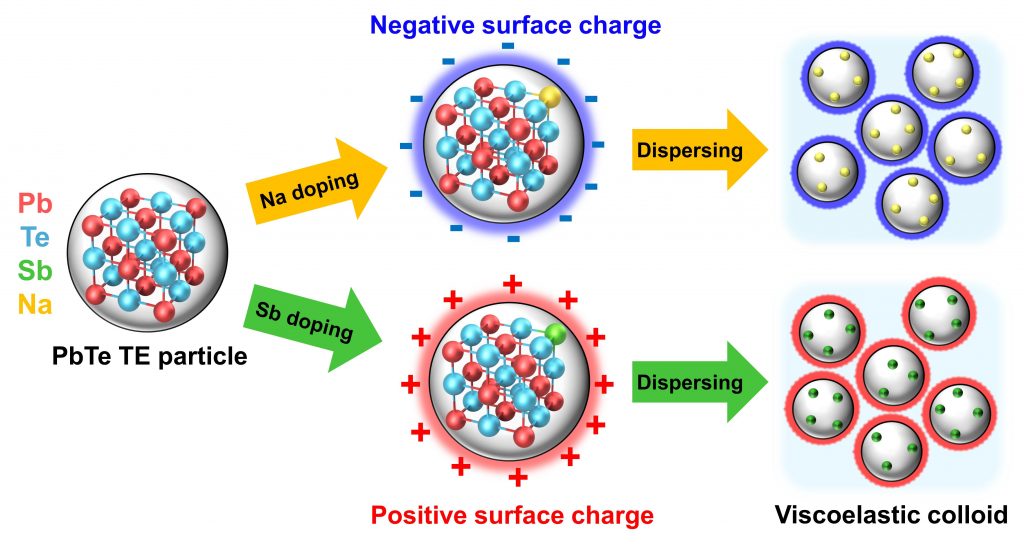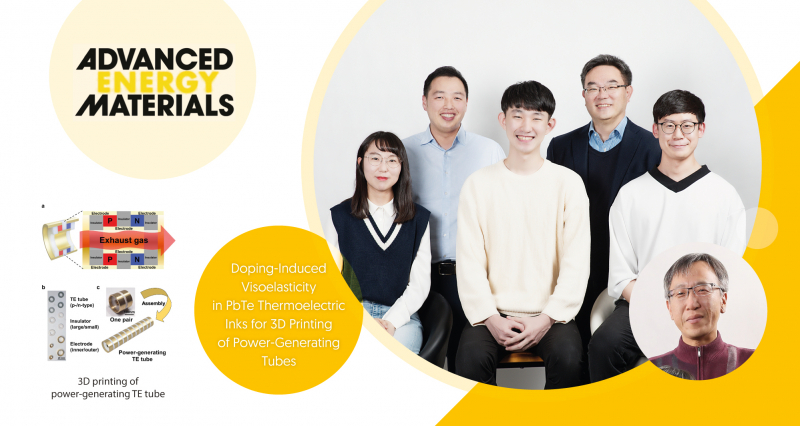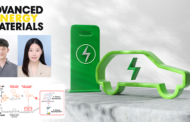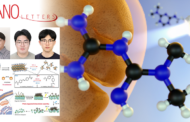A joint research team, affiliated with UNIST has announced that they have successfully developed a thermoelectric technology to produce power-generating tubes using 3D printing techniques. Researchers found that the tube-shaped device is more effective than conventional devices.
This breakthrough has been jointly led by Professor Han Gi Chae and Professor Jae Sung Son from the Department of Materials Science and Engineering, and Professor Sung Youb Kim from the Department of Mechanical Engineering at UNIST.

Figure 1. 3D printing of power-generating TE tube. a) Scheme showing the power-generating TE tube made of the 3D-printed p-type and n-type PbTe tubes at the front view. b) Photograph showing the components for the module assembly. c) Photograph of the fabricated power-generating TE tube chipping unipair of p-type and n-type PbTe legs and schematic model of a power-generating tube chipping ten pairs of TE legs assembled from the fabricated unit module.
“Through this research, we will be able to effectively convert heat generated by factory chimneys, the most common type of waste heat source, into electricity,” said Professor Son. He said this is because the existing thermoelectric devices were in rectangular parallelepiped shapes.
In this study, researchers created the thermoelectric tube using a 3D printed ink made of lead (Pb) and tellurium (Te). Metal particles were mixed inside a glycerol solvent to provide viscoelasticity, a status that exhibits both viscous and elastic characteristics. The tube has a high thermoelectric performance at temperatures between 400 and 800 degrees Celsius, which is the temperature range of a car’s exhaust gases. The tube shape makes it more effective in collecting heat than a conventional cuboid type.

Figure 2. Schematic illustration showing the doping-induced surface charges of Na- and Sb-doped PbTe particles generating viscoelastic colloids.
“If we use 3D printing technology in the production of thermoelectric materials, we will be able to overcome limits of conventional materials,” said Professor Chae. “The new technology for providing viscoelastic characteristics to 3D printed materials will be used in various other sectors.”
The findings of this research have been published in the online version of Advanced Energy Materials, ahead of publication, on April 15, 2021. It has also been featured on the front cover of Advanced Energy Materials. This study has been jointly participated by Professor Sangjoon Ahn, Dr. Jaehyung Hong, Professor Ji Eun Lee from Chonnam National University, and Jeongin Jang from Korea Electrotechnology Research Institute.
Journal Reference
Jungsoo Lee, Seungjun Choo, Hyejin Ju, et al., “Doping-Induced Viscoelasticity in PbTe Thermoelectric Inks for 3D Printing of Power-Generating Tubes,” Adv. Energy Mater., (2021).













Pingback: 3D Printed tiny Generators. | SV3Dprinter()
Pingback: New study unveils thermoelectric ink that turns car exhaust pipes into power generators - ScienceDaily - The Headline Update()
Pingback: New study unveils thermoelectric ink that turns car exhaust pipes into power generators - AVINASH YADAV()
Pingback: New study unveils thermoelectric ink that turns car exhaust pipes into power generators » Times of India : The News - Latest Top Trending News()
Pingback: New study unveils thermoelectric ink that turns car exhaust pipes into power generators - Alert Breaking News - United States()
Pingback: New study unveils thermoelectric ink that turns car exhaust pipes into power generators - New On News()
Pingback: New study unveils thermoelectric ink that turns car exhaust pipes into power generators - ScienceDaily - Space Force()
Pingback: New study unveils thermoelectric ink that turns car exhaust pipes into power generators | Masoud ILDEREMI()
Pingback: New study unveils thermoelectric ink that turns car exhaust pipes into power generators | The Factist()
Pingback: New study unveils thermoelectric ink that turns car exhaust pipes into power generators — ScienceDaily – Sprinex()
Pingback: New study unveils thermoelectric ink that turns car exhaust pipes into power generators -()
Pingback: New study unveils thermoelectric ink that turns car exhaust pipes into power generators - ScienceDaily - News Inside Point()
Pingback: New study unveils thermoelectric ink that turns car exhaust pipes into power generators - ScienceDaily - Verve times()
Pingback: 排気管を発電機に変える――廃熱を効率的にエネルギーに変える3Dプリント熱電チューブを開発 - fabcross for エンジニア()